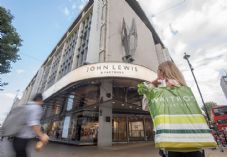UK DIY News
John Lewis Partnership Reports Losses Of £517m
Dame Sharon White, the chairwoman of the John Lewis Partnership, has written to Partners in the business advising of its unaudited performance during the year ended 30th January 2021.
Excerpts from the report follow:
1 2020/21 is a 53 week year and is reported on that basis. 2020/21 results have benefitted from an additional week’s trade compared to 2019/20. The impact on Profit before PB, tax and exceptional items is small.
2 All comparatives are reported after the adoption of IFRS 16. Last year we reported alternative performance measures before IFRS 16 and our 2019/20 Profit before PB, tax, exceptionals and IFRS 16 was £123m.
In a difficult year, the Partnership recorded a Loss before tax of £(517)m, compared to a Profit before tax of £146m in the previous year. This is the result of substantial exceptional costs of £(648)m, mainly the write down in the value of John Lewis shops owing to the pronounced shift to online, as well as restructuring and redundancy costs from store closures and changes to our head office. John Lewis shops are now held on our balance sheet at almost half the value they were before this year’s and last year’s write downs. Before the pandemic we judged that £6 in every £10 spent online with John Lewis was driven by our shops. The ratio has fallen to £3 in every £10.
Our Profit before exceptionals was £131m. While this was up £61m on the previous year, the Partnership would have made a loss before exceptionals if it weren’t for crisis-related support from the Government. We were helped by support from the Government of £190m, which was made up of business rates relief and furlough support (the latter claimed only to July 2020). Government funding has been used for the purpose it was designed for - to protect the business - and was critical to cover the direct operational costs relating to Covid and the substantial hit to trading operating profit. The business rates relief has helped to keep us running and avoid more severe restructuring of the Partnership, which would have put more jobs at risk at a time when the high street is already under pressure. We are not out of the crisis yet and the economic environment remains extremely uncertain. Therefore, our current intention is to accept the business rates relief made available from April to June, but we will keep this under review.
Trading operating profit was significantly challenged as the improvement seen in Waitrose, in part helped by the closure of the hospitality industry, was insufficient to cover the substantial decline in John Lewis as "non-essential" physical retailing closed temporarily. However, we improved our cost base with pension costs reducing by around £55m following the closure of the Partnership's defined benefit pension scheme in April 2020. There was also an almost £25m reduction in the depreciation of John Lewis Stores - i.e. less wear and tear - owing to their significantly reduced value in our accounts through the exceptional write down.
3 The additional week in 2020/21 is estimated to inflate the reported trading operating profit for the Partnership by around £30m (Waitrose £20m and John Lewis £10m). Adjusting for this, the Partnership trading operating profit would have declined by around £(128)m.
We entered this year with our financial performance already challenged - profits and Partner bonus having fallen for the past three years. We are having to take very difficult decisions to return the business to a path of sufficient profit of £400m by 2025/26. Last year we closed eight John Lewis stores and seven Waitrose stores that were loss making, and we are in the process of reducing the cost of our head office by 20%. We have seen limited impact from Brexit so far operationally owing to our advance preparations and the Brexit trade deal. The one area of the business that is temporarily disrupted is deliveries to Northern Ireland and we expect to resume these before the summer.
With a challenging external environment and difficult decisions as a Partnership, I could not be more proud of Partners. You have responded with exceptional agility - providing new services to customers, whose satisfaction with both brands has risen year on year.
LAYING THE FOUNDATIONS FOR GROWTH
Our rapid response to the crisis has laid the foundations of our growth:
- The benefit of being one Partnership with two brands is that more than 4,500 Partners from John Lewis were redeployed to Waitrose during the various lockdowns helping to keep the nation fed, and avoiding £15m in additional costs.
- Waitrose.com has grown fourfold since February 2020, now taking around 240,000 orders a week, and stands as a £1bn sales business. This expansion was supported by the opening of a new customer fulfilment centre in Enfield last May, and the extension of online picking and delivery, which is now available in 260 of 331 Waitrose shops. We also trebled our ‘Rapid’ delivery service within the first month of lockdown. This has all made Waitrose.com the fastest growing online retailer, growing at more than double the market rate according to Kantar.
- Johnlewis.com has grown significantly, up 73%, and this year was three quarters of the brand’s sales, from 40% before the crisis.
- Services - previously only available in-store like nursery, home interiors advice, wine tasting and cookery courses - went online, with Partners supporting customers in a personal way via Zoom and apps. A Guinness World Record was broken with the largest ever virtual beauty event masterclass with Charlotte Tilbury.
- A trial partnership with Deliveroo has attracted younger new customers and is available through 40 Waitrose shops.
- Click & Collect is now available at over 900 locations, nearly 400 of which were added in nine weeks, up from 458 last year. Purchases from Boden, Sweaty Betty and Nespresso can now be picked up through our network.
- 30 new fashion and beauty brands have been launched in store and online, with a further 50 being introduced, many of them independent and British.
- John Lewis achieved its highest ever net promoter score of 70, up 4 points year-on-year (ie many more customers recommending the brand than not), and Waitrose’s customer satisfaction score rose 5.5 percentage points to 69%.
THE YEAR AHEAD
We now have a five-year Partnership Plan. The first priority is to reduce our costs and reinvest the proceeds in improved customer service to ensure that John Lewis and Waitrose remain the go-to brands for quality, value and sustainability, with greater ease and convenience. With retail margins declining and the Partnership wishing to return more benefit to Partners, customers and communities, we are aiming that by 2030, 40% of our profits will come from areas outside retail, namely financial services, housing and outdoor living.
The outlook is uniquely uncertain as the country charts its exit from lockdown, with non-essential retail in England due to open on 12 April at the earliest; and the timetable varying in Scotland and Wales. No one has a crystal ball to predict the strength and pace of the recovery - or the future course of the virus. Our priority is to make sure that the Partnership is well placed to serve our customers, however they want to shop with us. We are expecting working from home to be at higher levels than before the crisis as more people work a ‘hybrid’ of home and office.
Many customers will have accumulated savings over the past year, having been less able to spend on holidays and going out6. This pent up demand might be spent shopping or on the experiences that they have been deprived of in the past year. Equally, with unemployment and inflation both forecast to rise7our customers may be more hesitant about spending and more cost conscious.
6 According to Bank of England data - https://www.bankofengland.co.uk/bank-overground/2020/how-has-covid-affected-household-savings
7 Office for Budget Responsibility (OBR)
FUNDING THE PLAN
We managed cash tightly through the year and intentionally slowed investment when the crisis hit to preserve cash. We also obtained new medium term bank loans of £150m, and raised £136m from the sale and leaseback of 11 Waitrose shops.
Consequently, our liquidity as of January 2021 was abnormally high with £1.5bn cash plus bank facilities of £500m. The cash balances will be required to help meet our obligations - we carry £2.1bn of total net debts (including pensions and leases), with £575m of borrowings due to be repaid in the next 4 years. They will also provide us with a buffer to withstand material volatility in trading. Managing cash prudently is particularly important for the Partnership as we cannot raise money from equity capital markets by design of our structure.
We are targeting a £300m a year cost reduction by 2022/23. Our cash position and focus on cost will allow us to fund our critical turnaround - to secure and grow the Partnership for the benefit of current and future generation of customers and Partners. We expect our liquidity levels to normalise over the medium term as we invest in our plan and repay borrowings and we will continue to manage cash tightly.
GROWTH PLANS
We plan to invest £800m in 2021/22 to support our turnaround, approximately 40% higher than recent years. Given this raised level of investment, we expect our financial results - including liquidity, debt ratio, and profit before exceptionals - to worsen in 2021/22 and then improve in later years.
Investments include:
- digital investment across both brands, at a significantly higher level than recent years;
- improvements in our store estate;
- updating of major category propositions such as Home, and refresh of financial services products such as home insurance;
- new capacity at our John Lewis Magna Park distribution site to handle a higher volume of sales during Christmas;
- restructuring to reduce costs.
We will provide an update later in the year as to how we are ensuring best value for John Lewis customers as we finalise our review of Never Knowingly Undersold, informed by intensive customer research.
FUTURE OF JOHN LEWIS STORES
As spending shifts online we want to ensure our stores reflect how customers want to shop - ‘right space, right place’.
Our shops will always be important and we are proud of our presence on the high street across the country. They provide a sensory experience that online cannot, supported by the expert advice of Partners. And both brands will remain a blend of stores and online.
We’ve undertaken substantial research into how shopping habits vary in different parts of the country and between online and stores. Customers tell us they want to shop John Lewis closer to home in more convenient locations and they want our stores to be more enticing. We will reshape our store estate over the five years of the Partnership Plan towards:
- Destination stores: showcasing our inspiring products - displaying great design with more space given over to experiences and services that cannot be found anywhere else.
- Smaller service stores: new formats of smaller, more local shops with the very best of John Lewis.
- Bringing our brands closer together: we are trialling the introduction of John Lewis shopping areas in Waitrose stores in Godalming, Horley, Wallingford, Lincoln and Lymington; the early signs are positive. If successful, we will roll out to a significant number of our 331 Waitrose shops. Our plan is for all the general merchandise in Waitrose shops to be sourced from John Lewis.
- Even greater convenience for customers: improved Click & Collect service in Waitrose stores and more local collection points through third parties like the Co-op.
All our John Lewis stores need to be exciting places to shop, more reflective of the tastes and interests of local customers. This will require investment and we are working closely with landlords and local authorities. We are keen to play our part in the revitalisation of the high street.
Hard as it is, there is no getting away from the fact that some areas can no longer profitably sustain a John Lewis store. Regrettably, we do not expect to reopen all our John Lewis shops at the end of lockdown, which will also have implications for our supply chain. We are currently in discussions with landlords and final decisions are expected by the end of March.
Closing a store is one of the hardest decisions we can make as a Partnership. We are acutely sensitive to the impact on our Partners, customers and communities, particularly at a time when retail and our high streets are undergoing major structural change. We will do everything we can to lessen the impact and will continue to provide community funds to support local areas.
A national effort of business, local and national government, and community will be needed to address the challenges facing the high street, communities and jobless youngsters from the sheer speed at which Covid is altering the structure of the economy.
We are going through the greatest scale of change in the Partnership’s 156-year history. As employee-owners, we share the responsibility of securing the Partnership for future generations of customers and Partners. Difficult decisions taken now will hopefully set the course for those next generations.
I know I am asking so much of Partners. Retail is changing fast around us. And the Partnership is adapting just as fast. What won’t change are the principles and values in which the Partnership is rooted. We have withstood our toughest test and emerged stronger. The strength of the Partnership has seen us successfully navigate the pandemic and will see us to a successful future.
Click here to view the full results presentation.
Source : John Lewis Partnership
I find the news and articles they publish really useful and enjoy reading their views and commentary on the industry. It's the only source of quality, reliable information on our major customers and it's used regularly by myself and my team.











































